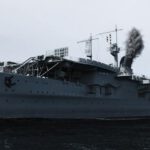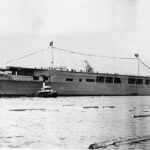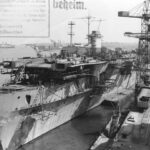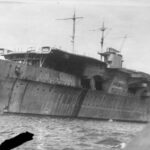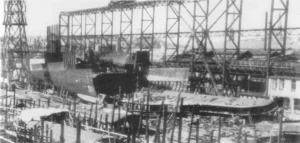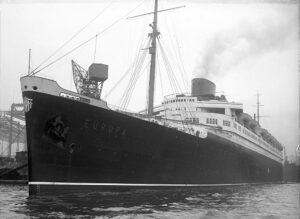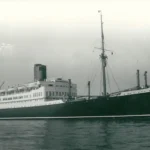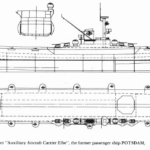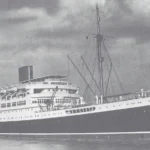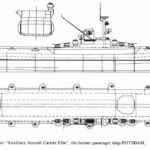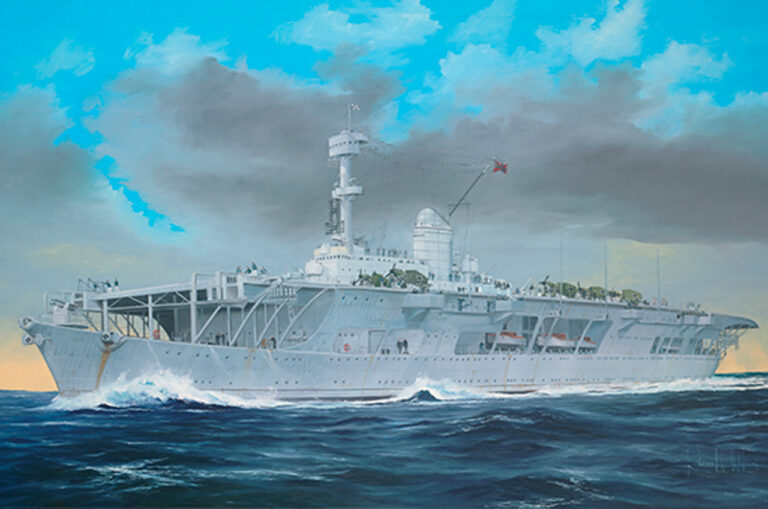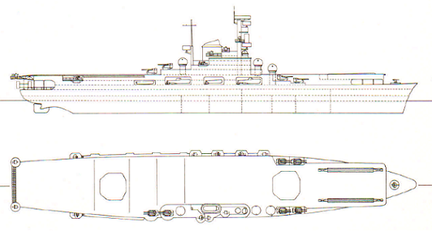
The history of German aircraft carriers is a story of ambitious projects that were never completed, primarily during the Nazi era leading up to and during World War II. Germany never commissioned a functioning aircraft carrier, due to a mix of inter-service rivalries, political indecision, and shifting wartime priorities. Over time, the German Empire planned the construction of several aircraft carriers (German: Flugzeugträger). Construction of some actually began, and one was actually completed and launched. This was the German aircraft carrier Graf Zeppelin.
During World War I, there was an attempt by the German Empire to convert the unfinished Italian passenger liner Ausonia into an aircraft carrier, codenamed “I”. Plans were also afoot to convert SMS Roon to become a seaplane tender.
During World War II, Nazi Germany attempted to build several aircraft carriers. Two of these were to be of the Graf Zeppelin class, Flugzeugträger A Graf Zeppelin and Flugzeugträger B Peter Strasser. Only the Graf Zeppelin was launched. At the same time, there was an attempt to convert the ocean liner Europa into the carrier codenamed “I”. The incomplete German cruiser Seydlitz was also started to be converted into an aircraft carrier.
German Aircraft carriers:
Name | Class | Laid down | Commissioned | Notes |
I (1915) | -- | 1914 | -- | Scrapped in 1922 |
Graf Zeppelin | Graf Zeppelin | 1936 | -- | Sunk as target 24-07-1947 |
B | Graf Zeppelin | 1936 | -- | Scrapped in 1940 |
I (1942) | -- | 1927 | -- | Seized by the US Army in 1945 |
Jade | Jade class | 1934 | -- | Sunk 02-05-1943 |
Elbe | Jade class | 1934 | -- | Seized by Great Brittain 20-06-1946 |
Weser | -- | 1936 | -- | Scrapped in 1976 |
II | -- | 1938 | -- | Returned to France in 1945 |
I (1915)
The aircraft carrier I was the first planned aircraft carrier conversion project of the German Imperial Navy (Kaiserliche Marine) during World War I. The Imperial Navy had experimented previously with seaplane carriers,
though these earlier conversions were too slow to operate with the High Seas Fleet and carried an insufficient number of aircraft. I was intended to carry between 23 and 30 aircraft, including fighters, bombers, and torpedo-bombers.
The ship was based on the incomplete hull of the Italian passenger ship Ausonia, which was being built in Hamburg. After World War I ended, high inflation in Germany added to the cost of the ship, and as a result, the Italian shipping company for whom the ship was originally built, declined to purchase her. The vessel was therefore sold to shipbreakers and dismantled in 1922.
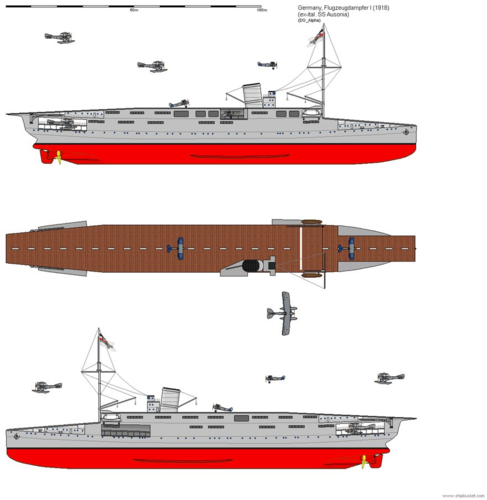
Graf Zeppelin class
The Graf Zeppelin-class aircraft carriers were four German Kriegsmarine aircraft carriers planned in the mid-1930s by Grand Admiral Erich Raeder as part of the Plan Z rearmament program after Germany and Great Britain signed the Anglo-German Naval Agreement. They were planned after a thorough study of Japanese carrier designs; nevertheless, German naval architects ran into difficulties due to lack of experience in building such vessels.
A combination of political infighting between the Kriegsmarine and the Luftwaffe, disputes within the ranks of the Kriegsmarine itself and Adolf Hitler’s waning interest all conspired against the carriers. A shortage of workers and materials slowed construction still further and, in 1939, Raeder reduced the number of ships from four to two. Even so, the Luftwaffe trained its first unit of pilots for carrier service and readied it for flight operations. With the advent of World War II, priorities shifted to U-boat construction; one carrier, Flugzeugträger B, was broken up on the slipway while work on the other, Flugzeugträger A (christened Graf Zeppelin) was continued tentatively but suspended in 1940. The air unit scheduled for her was disbanded at that time.
The role of aircraft in the Battle of Taranto, the pursuit of the German battleship Bismarck, the attack on Pearl Harbor and the Battle of Midway demonstrated conclusively the usefulness of aircraft carriers in modern naval warfare. With Hitler’s authorization, work resumed on the remaining carrier. Progress was again delayed, this time by the demand for newer planes specifically designed for carrier use and the need for modernizing the ship in light of wartime developments. Hitler’s disenchantment with the performance of the Kriegsmarine’s surface units led to a final stoppage of work. The ship was captured by the Soviet Union at the end of the war and sunk as a target ship in 1947.
I (9142)
The German aircraft carrier I[Note 1] was a planned conversion of the transport ship Europa during World War II. The loss of the battleship Bismarck and near torpedoing of her sistership Tirpitz in May 1941 and March 1942, respectively, spurred the Kriegsmarine to acquire aircraft carriers. Europa was one of several vessels selected for conversion into auxiliary aircraft carriers.
Conversion planning began in May 1942, and had the conversion been finished, she would have been the largest German aircraft carrier, longer even than the purpose-built Graf Zeppelin-class aircraft carriers. The work was canceled in November 1942, however, after design problems, including serious instability and structural weaknesses, proved to be irreconcilable. No work was done on the ship, which was eventually seized by the US Army and used as a troop transport following the end of the war.
Jade class
The Jade class comprised a pair of passenger ships intended to be converted into auxiliary aircraft carriers by the German Kriegsmarine during World War II. The two ships were launched as Gneisenau and Potsdam in 1935. After the outbreak of war, the ships were requisitioned by the Kriegsmarine as transports, and in May 1942, plans were drawn up to convert them into aircraft carriers. The ships were not identical, but were similar enough in size to allow identical outfitting.
Gneisenau and Potsdam were to be renamed Jade and Elbe, respectively. Work on Jade was not started and the conversion project was abandoned in November 1942. She returned to service as a troopship, only to be sunk by a mine in the western Baltic. Elbe actually began the conversion process in December 1942, but only her passenger fittings were removed by the time work was halted in February 1943. She was converted into a barracks ship in Gotenhafen and seized by Great Britain after the end of the war. She remained in use until 1976, when she was broken up for scrap.
Weser
Seydlitz was a heavy cruiser of the German Kriegsmarine, fourth in the Admiral Hipper class, but was never completed. The ship was laid down in December 1936 and launched in January 1939, but the outbreak of World War II slowed her construction and fitting-out work was finally stopped in the summer of 1940 when she was approximately 95 percent complete. The unfinished ship remained pier-side in the shipyard until March 1942, when the Kriegsmarine decided to pursue aircraft carriers over surface combatants. Seydlitz was among the vessels chosen for conversion into auxiliary aircraft carriers.
The ship was renamed Weser. Work was not completed, however, and the incomplete vessel was towed to Königsberg where she was eventually scuttled. The ship was seized by the advancing Soviet Army and was briefly considered for cannibalization for spare parts to complete her sistership Lützow for the Soviet Navy. This plan was also abandoned, and the ship was broken up for scrap.
II
The aircraft carrier II was a proposed conversion project for the incomplete French cruiser De Grasse. The ship was laid down in November 1938 and lay incomplete in the Arsenal de Lorient shipyard when Germany invaded France in May 1940. In 1942, the German Kriegsmarine decided to convert the cruiser into an auxiliary aircraft carrier. Work ceased in February 1943, however, due to concerns with the ship’s design, a severe shortage of material and labor, and the threat of Allied bombing raids. The ship was eventually completed as an anti-aircraft cruiser in 1956 by the French Navy.
References:
1. https://military-history.fandom.com/wiki/List_of_aircraft_carriers_of_Germany
